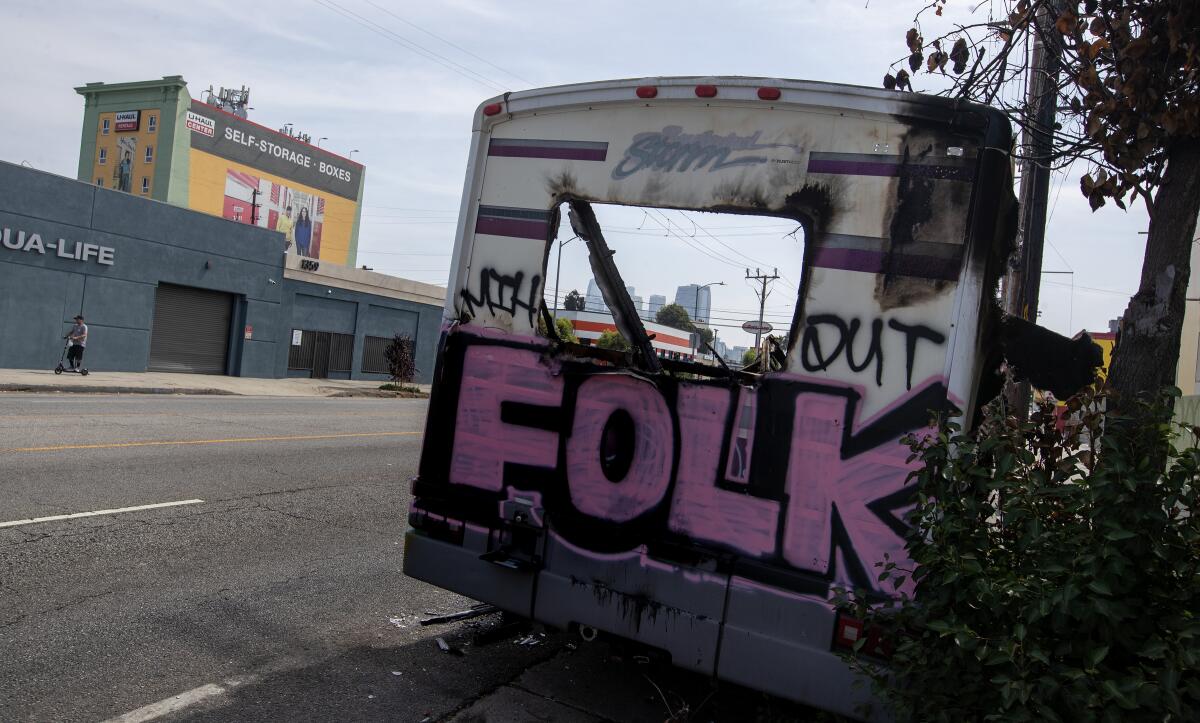LA officials direct traffic officers to enforce parking laws, tow RVs that people live in

- Share via
The Los Angeles City Council gave the go-ahead on Friday to tow illegally parked vehicles in large swaths of the city, granting workers more latitude to immediately remove RVs and other vehicles that homeless people sleep in.
Officials have been struggling to gain control over the proliferation of RV encampments after a pandemic moratorium on towing them was lifted two years ago. Since then, traffic officers had to go through a lengthy process to ensure the vehicles weren’t occupied. If they were, they had to offer housing outreach services.
Councilmember John Lee, who proposed the more expansive restrictions on camping, said the measure “puts our city back to where we need to be and hopefully meets the expectations of the residents of our city that we enforce the laws and rules that we already have on our books.”
The council voted 11 to 3 to allow the towing of vehicles creating “an immediate public safety hazard” or parked in a peak-hour travel lane, in a measure proposed by Eastside Councilmember Kevin de León.
Councilmembers Eunisses Hernandez, Nithya Raman and Hugo Soto-Martinez dissented.
In an amendment authored by Lee, city workers won’t have to offer housing services if vehicles are without a permit in overnight zones and or in no-parking, no-stopping or metered zones.
The amendment passed with narrower margins — Councilmembers Marqueece Harris-Dawson, Hernandez, Raman and Soto-Martinez opposed wider parking restrictions.
The policy doesn’t change parking rules but aims to enforce already existing laws. It provides traffic officers the ability to tow vehicles that are in those zones if they pose a traffic safety or public health hazard, interfere with public works, are inoperable or if their registration is more than six months lapsed.
Some members expressed doubt about how the rules will be enforced.
“I had to personally call the Department of Transportation to come out into enforcement areas, “ said Councilwoman Monica Rodriguez, whose council district covers the northern edge of the San Fernando Valley. Their response has been “well, we’re under-resourced,” she said. “However, they’re not under-resourced when they go into certain neighborhoods. They only happen to be under-resourced when it came to mine.”
In previous years, the city’s transportation department lacked funding, storage space and equipment to remove large vehicles — and found it difficult to locate RV occupants, which complicated the impounding process.
“Right now, our DOT department is struggling to cover the work that it already has to do,” said Hernandez. “We didn’t give them any extra resources for enforcement. If a significant number of these vehicles are RVs, we don’t have enough garage space to tow them all.”
Nearly 6,900 RVs were counted in L.A. as of 2024, according to the L.A. Homeless Services Authority. However, some dwellers don’t consider themselves homeless, and refuse to live in restrictive shelters.
Raman, who voted no on both amendments, said the motion could supersede the city’s efforts to address RV homelessness.
“It essentially says that all of the other policies developed by the [City Administrative Officer] that have been put forward by Councilmember Rodriguez on RV buyback are going to be moot and that we are going to be moving towards another model,” Raman said. “The amendment is overbroad.”
The new policy comes down to public safety, said Peter Brown, a spokesperson for De León.
“The proliferation of RVs around the city comes with increased safety risks on our streets,” said Brown. “Safety on our streets is essential. I think you’re going to have locations where risks for pedestrians, cyclists and motorists are reduced.”
More to Read
Sign up for Essential California
The most important California stories and recommendations in your inbox every morning.
You may occasionally receive promotional content from the Los Angeles Times.












